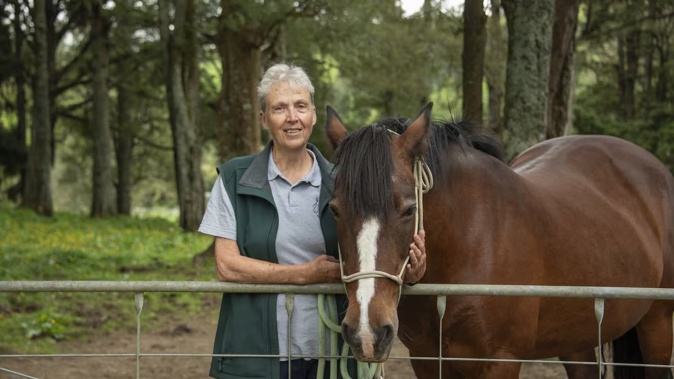

NZME’s On The Up is a national campaign showcasing amazing stories of inspiration, success, courage and possibilities. In this story, Catherine Fry of Coast & Country News catches up with equine-assisted therapist Sue Court, of EarthHorse Aotearoa, in Waitetuna Valley, Raglan.
Equine-assisted therapist Sue Court didn’t have horses as a child, but admits her friend choices may have been a little biased towards horse owners and managing the occasional ride.
During her adult years, she and her wife, Sarah, bought a small farm in New Zealand and devoted all their spare time to learning how to ride, care for, and have fun with horses.
It was towards the end of the 1990s that Sue first heard about equine-assisted therapy.
She was surprised to learn it was therapy for people rather than horses.
At the time, although working with horses was a much-loved activity, she was employed as a university lecturer.
A change of career
Previously, Sue’s passion for music led to her studying classical guitar in London, Otago and Rome, ultimately gaining a PhD in the history of Italian music.
She then worked as a professor, followed by university management, which took her to an Australian university.
As her Australian employment was nearing the end, Sue retrained as an equine-assisted therapist and a counsellor.
The couple came back to New Zealand, where Sarah also trained as a counsellor.
They have since built up an equine-assisted therapy business together.
Fascinated by animals

Miniature horse Pippin is especially good with children. Photo / Catherine Fry
Sue has always had animals in her life and has bred cattle and goats in modest numbers on small farms she has owned.
“Animals were always an important part of my childhood,” she said.
“They know who they are and how to be their best selves, whereas humans find such self-knowledge much more elusive.”
Because mammals don’t have the large prefrontal cortex that humans enjoy, they tend to base their decisions more on physical needs and survival.
Humans do too, but while we apply our massive brain to useful and complex calculations, we also complicate our mental lives by overthinking about the past and the future.
“Horses model for us healthier living in the present moment and how to view the world more broadly,” Sue said.
“For instance, as prey animals with near-360-degree vision from eyes positioned on the sides of their heads, they teach us not to be so single-minded in our focus.
“This is something people can learn both physically and as useful life lessons, showing us how narrow focused we have become.”
Horses teach compassion and can be seen showing kindness and looking after one another in the herd, as one horse at a time becomes a sentinel while the others rest.
For this reason, horses do not enjoy being paddocked alone because they can’t relax.
They also need companionship to participate in allogrooming, where they groom each other in the hard-to-reach areas.
In their own herd of seven horses, Sue and Sarah see healthy social behaviours modelled, where they respect and nurture one another while being led by a head mare who avoids micromanaging.
“If two horses have a disagreement, she looks at them as if to say, ‘hey guys, sort it out, or I will’.
“So, they have a lot to teach us about social living through observing their social interactions.”
Equine-assisted therapy

Sue and Gypsy share a gentle, calm and relaxed relationship. Photo / Catherine Fry
Sue said that while observation of horse behaviour was a key aspect of the therapy work, another useful tool was metaphor, which naturally arose when a client worked one-on-one with a horse.
It allows projection and personal narrative to arise and leads to discussion of the dynamics within the client’s life.
How a horse behaves is likely to be taken personally in some way; for instance, a horse looking in another direction or refusing to walk beside a client might be interpreted as not wanting to be with them.
Observing both the horse and the client’s reactions leads to discussion of personal narratives, opening opportunities for reflection and change.
Heightened senses
“A horse lives in the moment, doesn’t spend time worrying, carries no mental baggage, and if one upsets the other, they don’t hold on to resentment but quickly go back to grazing,” Sue said.
“This is one way that horses beautifully model to humans how to let go of anger without holding on to resentment.”
Horses are attuned to our body language and magically seem to know what we are experiencing, but in truth, this is not a magical process.
With their heightened sense of smell (similar to a dog’s), superior vision and hearing, plus sensitivity to touch, they accurately “read” other beings.
They smell adrenaline and other biochemicals within humans, they read our body language accurately and know our emotional states better, sometimes, than we know ourselves.
“We are very blessed with these beautiful animals since they are so kind and generous around humans and very willing to lead us to healthier lives.”
Sue published a book on equine-assisted practices last year and is now writing a second book.
Take your Radio, Podcasts and Music with you









